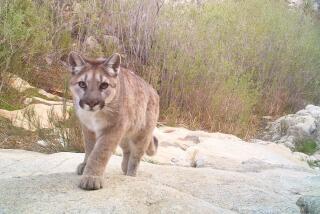As Southern California cougars near ‘extinction vortex,’ a radical rescue plan emerges
The future is looking increasingly bleak for some Southern California mountain lions.
Urban encroachment, inbreeding, vehicle strikes, rat poison and wildfire have all taken their toll on cougars living in the Santa Monica and Santa Ana mountains.
Now, research published Wednesday suggests there’s an almost one-in-four chance the charismatic cats could become extinct in those areas within 50 years.
In the face of such a dire prognosis — what biologists call an extinction vortex — conservationists are considering a desperate and controversial remedy: capturing pumas in one part of the Santa Anas and trucking them across the 15 Freeway so that they can breed with isolated mates on the other side of traffic.
“Wildlife managers never want to be a shuttle service for wild animals,” said Justin Dellinger, senior environmental scientist with the Wildlife Investigations Laboratory at the California Department of Fish and Wildlife. “But translocation has potential merit in the short term — after all it helped bring the critically endangered Florida panther back from the brink.”
Mountain lions are not endangered in California, but groups living in the Santa Monica and Santa Ana ranges now find themselves in genetic peril. Separated by freeways and lethal traffic, they are unable to range freely and are growing increasingly inbred, researchers say.
In the Santa Monica Mountains, the 101 Freeway exists as a near impenetrable barrier to gene flow for a group of 10 mountain lions; In the Santa Ana Mountains, the 15 Freeway limits the movement of a family of 20 cougars.
Sometimes, the animals manage to cross freeways without getting hit. At least seven cougars have crossed the 15 Freeway near Temecula in the last 15 years, and one sired 11 kittens. The fact that only one managed to reproduce, however, shows how difficult it is to diversify the gene pool in the lions still prowling the range.
A population viability study published in the journal Ecological Applications predicts extinction probabilities of 16% to 28% over the next 50 years for these lions, which have the lowest genetic diversity documented for the species aside from the critically endangered Florida panther.
Study authors note also that wildfire and disease could result in “catastrophic mortality” and further hasten the animals’ disappearance.
However, extinction probabilities were significantly reduced when computer models simulated the influence of two immigrant lions per year in areas blocked by development and freeways, according to a team of researchers that included Winston Vickers, an associate veterinarian at the UC Davis Karen C. Drayer Wildlife Health Center, and Seth Riley, an ecologist with the Santa Monica Mountains National Recreation Area.
Shuttling mountain lions from one area to another might be “an especially valuable option,” study authors wrote. “Given the expense of erecting highway crossing structures, translocation would certainly be a less expensive strategy, especially in the short-term.”
However, there exist numerous obstacles to the shuttle solution.
Translocation of mountain lions is forbidden by state law. But state Department of Fish and Wildlife officials have not ruled out the possibility of granting an exemption under certain conditions.
“It could be a slippery slope,” Dellinger said. “For instance, you can’t just turn a male mountain lion loose in new territory without making existent lions unhappy about it. There are also liability considerations, as well as the worrisome possibility that as soon as you let a mountain lion go on the far side of a freeway, it might try to cross back over.”
A translocation program would also be controversial and require fulfillment of a mountain lion’s basic creature comforts. Among them, at least 200 to 300 mule deer per translocated predator in order for it to, as Dellinger put it, “stay put in a given area.”
In some cases, wildlife advocates are opposed to the concept.
In the Santa Monica Mountains, conservationists say there is no need for translocation. They say the problem can be solved with the construction of a $60-million wildlife overpass that crosses the 101 Freeway in Agoura Hills.
The bridge could help diversify the gene pool among the mountain lions remaining in the Santa Monicas south of the freeway as well as in the Simi Hills and Santa Susana Mountains to the north, they say.
Because the bridge crosses the freeway, Caltrans will oversee design and construction — but the transportation agency is not providing funding. Instead, roughly 80% of the funds are expected to come from private philanthropy and corporate donations.
As of February, its fundraising campaign had brought in about $7.5 million, including $1 million from the Annenberg Foundation, $250,000 from the Leonardo DiCaprio Foundation, $100,000 from Boeing Co. and $175,000 from an 80-year-old couple in Kansas, National Wildlife Federation officials said.
“We believe about $30 million to $40 million of the funding will come in one check signed by a person who wants to see their name on the bridge,” said Beth Pratt, California director of the federation. Although the bridge was intended to be built by 2022, proponents say it could be delayed.
Farther south however, conservationists are open to the idea of translocation, even as they work with the California Department of Transportation on a relatively low-cost plan to improve 15 Freeway underpasses that would allow cougars freedom to roam.
Separately, conservation organizations led by the Center for Biological Diversity, the Sierra Club, the Mountain Lion Foundation and Cougar Connection have sued the city of Temecula in Riverside County Superior Court for approving a proposed housing project that would encroach on wildlife corridors linking coastal mountains and protected nature reserves to the east.
Recently, three of the biologists leading the mountain lion recovery work in the Santa Anas stood on a hilltop just west of Temecula and gazed down on a weedy creek flowing from nearby mountains, under the 15 Freeway and then eastward past neighborhoods, shopping centers, golf courses and condominiums.
To the uninitiated, it was a mildly depressing vista of unbridled urban development. But that’s not what the people gathered on the hilltop saw.
“You’re looking at little Temecula Creek,” said Trish Smith, lead biologist of The Nature Conservancy’s efforts in the area. “The last natural wildlife corridor in this area and ground zero of our efforts to save a magnificent animal from extinction.”
More to Read
Start your day right
Sign up for Essential California for news, features and recommendations from the L.A. Times and beyond in your inbox six days a week.
You may occasionally receive promotional content from the Los Angeles Times.







